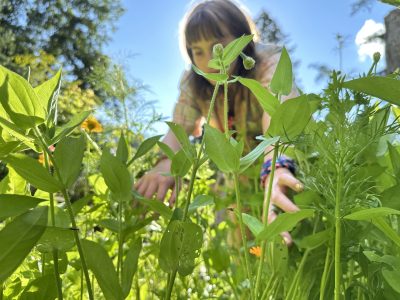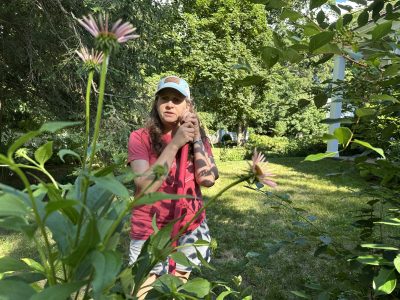‘Less Lawn, More Life’: Exploring Sustainable Planting Before a Pollinator Garden Tour
Opinion Advocates for ideas and draws conclusions based on the author/producer’s interpretation of facts and data.

By Tessa Wheeler, Examiner Reporter Intern
Humidity presses down on my skin as I watch my mother striking into the earth with a shovel, making room in the soil next to some proud pink coneflowers. The long, stalky coneflower she’s replanting is drooping and wilted—in this heat, I feel the same. Still, bees and wasps excitedly dance around my head, bouncing off of single-stalk flowers that nearly match my height at five-foot-eight. I duck when crossing our front walkway to avoid a flowering branch reaching to the sky—inside of one of its blooms, a honeybee is drunk on pollen.
We’re doing the rounds on our plants to prepare for an upcoming event, one my mother and sister have been buzzing about for weeks now: the Northern Westchester Pollinator Garden Tour, hosted by Healthy Yards Westchester. On Sunday, July 13, our property will be among more than 30 others open to the public, hoping to spread the message of “Less Lawn, More Life.”
A Sustainable Start
Healthy Yards was founded 10 years ago by Filippine Hoogland and Fiona Mitchell of Bedford. Hoogland was working in landscaping when she met Mitchell (described by Hoogland as a “master gardener”) who’d co-founded the “Leave Leaves Alone” initiative in Bedford a few years prior. Hoogland, who expressed frustration with current landscaping practices in an interview with me, talked to Mitchell about innovating change in landscaping—“moving away from conventional approaches that harm the environment,” she said, and “toward more sustainable methods that support biodiversity.”
Following the release of a 2019 report that showed 40 percent of the world’s insect population was being threatened by extinction, Healthy Yards realized the importance of bringing attention to pollinators.
“The pollinator tours began as a means to show people what sustainable yards could look like,” Hoogland explained. “Not just perfect beautiful gardens, but landscapes, big or small, that prioritize native plants and habitat over aesthetics.”

For my mother, Kate Brady, her sustainable yard journey began with one plant.
“I really like peonies,” she told me. ‘Like,’ though, doesn’t seem to cut it—we have more than 100 planted across our property. Many are heritage, passed down from generation to generation, gently carried over state lines when children moved away to start their own families.
Everything changed, though, when one day some years ago my father brought some purple coneflowers (a plant native to New York) home. After planting them, my mother noticed something.
“As they started blooming, we got a ton of butterflies with them. And bees,” she told me. “And I realized that with my peonies, I didn’t get any butterflies. I got no bees. I was so struck by the coneflowers, and how they seemed to add a lot of interest to the yard.”
The Pollinator Garden Tour offers others the chance to have the same realization my mother did, if they haven’t already.
“We hope both visitors and hosts find inspiration, useful knowledge, and answers to their questions,” Hoogland said.
Less Lawn, More Benefits
The phrase “Less Lawn” might sound like fighting words in suburbia, where manicured green lawns are praised as the gold standard. However, there are many benefits to increasing biodiverse landscaping and minimizing lawn area, as Hoogland showed me: “Reducing lawn space in favor of plantings will help conserve water, retain soil moisture, absorb excess rain, and reduce emissions and pesticide use.”
In fact, studies have shown that lawns planted with native plants can reduce water consumption by up to 60 percent.
You don’t necessarily need to get rid of your grassy front yard if you like how it looks, Hoogland told me. However, changes can be made in the backyard, where native flowers and shrubs can grow free. If native plant landscaping, however, isn’t feasible for any reason, then just plant trees. Hoogland says it’s one of the most impactful things you can do—especially given that Westchester was once 80 percent woodland.
Furthermore, diverse lawns work to enrich the surrounding soil and ecosystems in ways that monocultured lawns are unable to. Native plants each have their own functions and contributions to the environment, Hoogland emphasized. They all do different things to uphold their parts as small pieces in a large, complex ecosystem.
Rooted in Connection
Through community, Healthy Yards hopes to inspire change.
“The goal is to build momentum locally,” Hoogland noted, “so that, eventually, these efforts maybe even influence change at the state level.”
The group is involved in a ‘Plant Swap’ that takes place the last Saturday of every month at the Bedford Hills train station, and hosts a yearly seed swap, where attendees can receive free native plant seeds. The Westchester Pollinators Facebook group with 2,700 members is where Healthy Yards communicates much information to the community.
No Wrong Way to Do It
Neatness is in no way a prerequisite when it comes to gardening for pollinators. My family’s kitchen garden is swarmed with nasturtiums, and garlic scapes curl around dull-green leaves of kale, which hide carrots and radishes from the sun.
In areas on the property where we have flowers planted, it’s sometimes hard to see the ground or clear a walking path through. The space isn’t manicured—but the bees couldn’t care less. Hoogland is excited for the garden tour to demonstrate all kinds of pollinator gardens.
“While some gardens on the tour—like landscape designer Leslie Needham’s River Hills—are truly stunning, others are more modest or what some might even call ‘messy,’” she said. “But that’s the point: we want to show that doing less can also be valuable.”
“We try to expand our growth of things that are beneficial to the environment and are beneficial to pollinators,” my mother told me as she tended to a leggy plant in our front yard. “Some of those things end up being non-natives too, but that’s kind of okay—as long as they’re providing value.”
She’ll keep on planting beebalm, coneflowers, alliums, and geraniums. She’s started to let patches of clovers grow wild in the grass of our lawn. But her peonies? Those are going to stay. No, they’re not native—but they make her happy.
The Northern Westchester Pollinator Garden Tour is taking place this Sunday, July 13, at more than 30 properties. See this link for more information.

Examiner Media – Keeping you informed with professionally-reported local news, features, and sports coverage.
